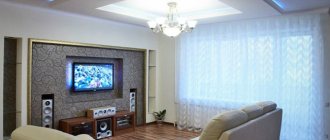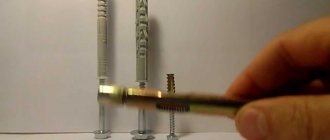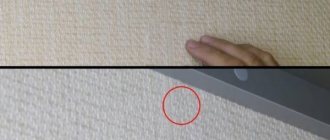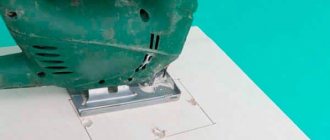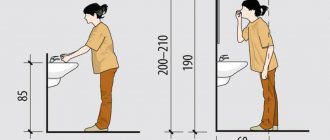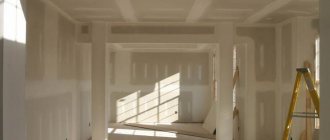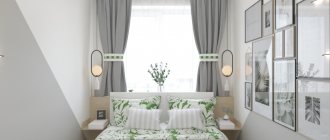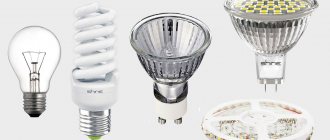Today, spotlights are becoming increasingly common. When installed on a suspended ceiling, a special subtle and sophisticated style of the room is formed. You can choose bright models and collect them above the center of the room, or you can choose “quiet” different colors and arrange them diagonally with a thin mysterious thread.
In addition to aesthetics, installing suspended ceiling spotlights in plasterboard has many practical advantages. Such structures are durable, their installation and possible replacement do not require complex specialized skills.
Spotlights: installation methods
Many people imagine what a spotlight is. How to install it is described in the article “Installation of a spotlight.” Based on the installation method, such equipment is divided into the following types:
- Overhead or external. They are used on frameless foundations such as concrete ceilings or brick walls. They are great for situations where it is necessary to change the interior without interfering with the dimensions of the room. They consist of two main parts: a mounting platform and a housing on which the diffuser is located. Installation is carried out by fixing the strip into a hole whose diameter is smaller than the body. This allows you to cover it with a lampshade in order not to lose its aesthetic appearance. It is also necessary to connect the grounding wire to the strip. After connecting the wires, the housing must be fixed on the site.
- Recessed spotlights. They are the most popular among their representatives. This is due to their easy installation into any surface and material. This can be plasterboard, suspended ceilings, furniture elements and niches of varying complexity. Recently, you can find spotlights not only in walls and ceilings, but also on the floor, in stairs, swimming pools, bars, and as lighting on kitchen units. As for their configuration, they also have their own characteristics. In most cases they consist of a solid structure. These are immediately combined fasteners and clamps. During installation, you only need to insert the lamp into a pre-prepared hole, into which the lampshade will be fixed using the claws. This gives them a major advantage in use and puts them at the forefront. A big plus is the huge range. Various textures, colors, sizes help everyone find the option they need.
- Hanging spotlights. They differ in the design of their body. Unlike its predecessors, it is located a short distance from the ceiling. The base for such lamps can be completely different: solid, tension and suspended. In practice, they are most often used as a decorative element to give the room a beautiful and aesthetic appearance. Installation occurs by hanging the lamp on a decorative cable, which is fixed to the ceiling. Looks good in the bedroom or living room
When choosing a spotlight, you should pay attention to the design of the room and the type of niche in which it will be installed.
Crown for installing mounting boxes
The most common need to drill round holes in drywall is to install electrical outlets. The invisible part of the socket, the plastic round mounting box that is mounted in the wall, is called the socket box. There are socket boxes for concrete, wood and plasterboard.
The socket box for drywall is a plastic cup with adjustable plates made of plastic or metal. Thanks to these “claws,” the socket box is fixed to the back side of the plasterboard sheet. The depth of the installation box can be 40, 50, 60 or 73 mm. As for the diameter, for a standard socket box it is usually 68-70 mm.
If you only need to drill holes to mount sockets, you will only need one hole saw. In this case, you should not purchase a set of dismountable crowns. It is enough to buy one special core drill, with a diameter of 68 or 70 mm (depending on the size of your socket boxes).
Today, the diameter of a core drill for drywall 68 mm is the most popular standard size.
Type of adjustment of spotlights
It is divided into several categories, which differ in type of construction, angle of light flux and its intensity.
- Rotary. Perfect for places where light adjustment is constantly required. However, during installation, it is recommended to strengthen the fastening point, otherwise, with frequent use, there is a risk of rapid wear of the material.
- Fixed. They cannot be rotated, which means they are intended only to illuminate a certain part of the room.
- Swivel and retractable. They help not only adjust the angle of light flow, but are also able to create lighting zones.
- Cardan shafts. Equipped with advanced adjustment of light intensity and flow.
- Spots. They have a rotating mechanism that helps you manually direct the light. Typically, several lampshades are placed on one fastener. They look especially aesthetically pleasing when they are placed in the form of geometric shapes.
- Downlight. They are used to illuminate a specific element of the room: paintings, photographs, niches with figurines.
The functionality of spotlights is also varied. Manufacturers offer different diameters, shapes and colors. The functional division is made taking into account the production configuration:
- the presence of a remote control is a modern option, convenient for high ceilings and hard-to-reach places;
- wide lighting angle;
- ability to adjust in different planes;
- resistance to high humidity;
- the presence of a special coating that protects against dust;
It is necessary to choose these characteristics based on the features of the interior and personal preferences.
Features of spotlights
Any spotlight consists of the following parts: a base attached to the surface, a body on which clamps and cables are located.
Lamps for incandescent lamps are divided into two groups:
- Open, it is characterized by a U-shaped design.
- Closed, its design is based on a special casing that protects from moisture.
An incandescent lamp implies heating at high temperatures, but even despite this, the housing does not require additional protection. And all this thanks to special built-in points that are located in the lamp. They are covered with mirror amalgam, which protects the entire structure from overheating.
Spotlights also have a number of characteristics that should be taken into account when choosing them for a room:
- The light scattering angle does not exceed 30 degrees. Thus, one lamp will not be enough even for the smallest room.
- the flow of light is cone-shaped.
Spot light has its advantages, which is why it is increasingly used in modern interiors. It looks especially advantageous in a space where you need to create visual work areas.
Components of spotlights
When purchasing a spotlight, you need to know what elements come with it in order to connect it to the power circuit:
- body with a diffuser, sometimes it is replaced with a retainer.
- mounting plate.
- block-terminal, but very often there is only a pair of terminals.
- lamp, but it is quite rare to find it included in a kit; usually you have to buy it yourself.
Types of lamps for spotlights Lamp for spotlights can be of several types.
Types of lamps based on operating principle
There are several types of lamps based on their operating principle:
- Incandescent lamps. Due to their fairly low price and easy replacement, they are the most common. However, recently the number of their disadvantages outweighs these two advantages. Disadvantages: they consume a lot of electricity and, due to the rather large fasteners, require a special frame.
- Halogen. They deserve attention due to their low energy consumption and long service life. And these are not all of their positive qualities; they are also distinguished by their brightness and shallow mounting depth. Disadvantages of halogen lamps: excessive heating and are easily contaminated with fats. It is recommended to carry out replacement with special gloves in order to maintain durability of use.
- LED spotlights. Unlike their predecessors, diode lamps have appeared recently. But in such a short period of time, they were able to gain the love of many customers. And all thanks to their main advantages. Low energy consumption - everyone who saves likes it. Such lamps never overheat, which means they are an excellent solution for those who prefer stretch ceilings. You should also focus on safety; they can be safely used in children's rooms. These lamps are also equipped with a rotating mechanism. This is very convenient, because at any time you can easily change the angle of the light.
- Luminescent Designed for use in industrial premises to simulate natural light. They are expensive, but their durability makes up for this. But their big disadvantage is that they are harmful and not environmentally friendly, but all because of the mercury content.
Types of socles
The lamp base is where the lamp is connected to the socket. They also come in different designs. The most common are threaded and pin.
Spotlights typically use E14, G5.3 and G10.
Thus, we can conclude that there is no ideal lamp. They all have their pros and cons. Therefore, when going to the store, you need to rely on the main factors, which include:
- light output is calculated by the ratio of the power of the light flow received from the lamp and the same volt indicator at the output;
- duration of operation;
- difficulties in disposing of a broken item;
- lamp replacement method;
- maintaining luminous flux;
- the need to use additional equipment.
In order for energy consumption to be rational, it is recommended to connect a rheostat (dimmer) to the lamp. This device will help you adjust the brightness of the lighting, but not all lamps can work with them. Only incandescent and special LED lamps.
Organization of the drilling process
Everyone uses different bits depending on their needs, but no matter what drill you use, there are general instructions for how to use them.
Which is better: heated floors or radiators?
Warm floorBatteries
The whole process can be divided into several stages:
- determining the location of holes on drywall;
- marking the surface material;
- attaching a core drill to a power tool;
- direct drilling.
At the first stage, you should decide where, how many, and what diameter the holes will be. It is better if you already have the elements to be mounted (lamps, socket boxes, etc.), then it will be easier to determine all the required hole diameters and thereby avoid unnecessary mistakes. Ideal if there is a clear layout diagram.
Next, the surface is marked. Measurements are taken and the center points of the holes are marked on the surface of the drywall, where the centering drill subsequently enters. Be careful that the hole does not hit the location of the metal profile, in which case you will be forced to cut the metal as well. If, for example, it is not clear from the heads of the screws where the profile is located, and you did not fasten the drywall, then you should find out where the metal goes before drilling; you may need to ask the team involved in the wrapping in advance to put some marks. There is another way to find out the location of the profile - use a search magnet. If you plan to place several elements nearby, then when marking, you need to monitor the level.
At the third stage, a crown of the required diameter is taken and installed on the power tool. This could be a drill or a screwdriver. To use a hammer drill, you need to purchase an adapter chuck and remember to turn off the impact mode.
Next, after you have made the calculations and markings, you can proceed directly to drilling. The centering drill of the crown is placed on the center of the future hole and the power tool is gently turned on. In this process, large tool power is not needed. The main thing is to hold the tool straight so as not to get a beveled cut. The drilling process can be carried out both on already fixed drywall, and on sheets that are not yet mounted, without using strong pressure on the plasterboard.
Drywall is a fairly soft material, and having a cutter of the right size and quality, it is not difficult to make a smooth hole, but still, if you doubt your abilities, trust the professionals.
Advantages and disadvantages of spotlights
If we consider spot lighting in general, we can highlight a number of main advantages:
- you can easily create zoning, with full or partial lighting;
- unlike chandeliers, longer service life;
- safety;
- energy saving;
- ability to change types of light bulbs;
- compactness, they can be used even in the smallest room;
- aesthetics and beauty;
- resistance to mechanical damage, you don’t have to worry that children will accidentally hit them with a ball;
- high efficiency;
- no flicker.
Like any other phenomenon, spot lighting has its disadvantages:
- difficulty in lighting design;
- for complete lighting it is necessary to use several elements at once;
- many models of spotlights require an additional frame;
- danger of use with a suspended ceiling (overheating can damage the material).
- additional care for each lampshade.
The photo of spotlights in this article will allow you to visually see how such lamps look in the interior. It will become easier to divide the space into zones. The spotlight easily fits into rooms intended for different purposes.
Is it possible to make holes in a suspended ceiling?
For fabric panels, the problem of cutting a hole is not as critical as for PVC. Still, the canvas has a reinforcing layer, and if you make a hole in the ceiling, then the maximum decorative coating will lose its original appearance. It is clear that stretched polyvinyl chloride film is not the best material for experimenting with punctures and cuts, but sometimes it is simply necessary to make a hole in the stretch ceiling for a self-tapping screw to attach a lamp or hanging decor.
What can you expect from an accidentally punctured hole in the ceiling:
- If the fabric is not tensioned correctly, there are local zones of constriction and ripples, then the hole is very likely to turn into a long hole or rupture line;
- The second option may be more dangerous. If you cut a hole in a suspended ceiling with a sharp and flat blade, for example, a stationery knife or scissors, then the film or even fabric is guaranteed to be torn in length to the nearest obstacle.
Choosing spotlights
Any purchase requires a careful approach and attention. The choice of spotlight was no exception. Here are the main factors you should pay attention to when purchasing a spotlight:
- It is necessary to ensure that all equipment was from the same manufacturer.
- It is good to check that the reflective and cooling element is complete.
- When purchasing a cable, you must first calculate its cross-section.
- If the choice fell on built-in models, it is recommended to buy them in advance in order to calculate the exact height of the frame.
Spotlights, pendant or recessed - this choice depends on the requirements of the room owners. Of course, when choosing lamps you need to rely on personal taste, but it is still recommended to adhere to certain subtleties.
So, simple lamps, without unnecessary patterns and decorations, are best suited for the kitchen. This will make it easier to care for them, because in addition to dust, greasy deposits will also accumulate on them. When choosing spotlights for a suspended ceiling, it is recommended to choose rounded models. This will make their installation easier and will not harm the ceiling material.
Devices with incandescent lamps are secured with special fasteners that visually “eat up” the space. Considering these subtleties, it will not be difficult to choose spotlights. You also need to pay attention to the color scheme, sometimes it affects the overall perception of the interior.
Selection of cutter
When you come to the store, it’s easy to get confused by the abundance of crowns on offer. How not to make a mistake with the choice so that it does not break when making the first hole?
- Take the crown in your hands and take a good look at it. If the product is of low quality, you will be able to visually immediately see, for example, elements of careless processing or defective coating. It is worth paying attention to the tail of the crown; if it is too light, it is made of low-quality metal and can quickly break;
- The centering drill and shank must be firmly secured, gaps are unacceptable. Also, if this is a dismountable bit, you need to check each cylinder included in the kit, how easily and evenly each of them fits into the groove of the disc. Make sure that none of the cylinders is loose in the groove, because the quality of the cut will depend on this;
- The element of the crown that bears the maximum load when drilling is the cylinders (glasses) with a serrated edge. The service life of the entire device depends on the quality of the material of this element. The saws should not be too thin and bend easily, the material should be elastic, otherwise you may not get a hole. Saws with hardened teeth are higher quality and more durable. Do not forget - the cutting teeth must ensure a clear and even cut of the material;
- Core drills come in different sizes (cylinder diameter, drilling depth), if you buy a set, make sure it has the one you need.
Spotlights: features of use
Compliance with operating rules is very important, because if you do everything correctly, you can significantly increase their service life.
Tips for placing spotlights:
- You should not install lamps at a distance of less than half a meter;
- Energy-saving lamps should be used for suspended ceilings;
- if you place several lamps around the perimeter of the walls, this will visually enlarge the room.
Care for spotlights must be appropriate, only then will their service life increase. Here are the basic tips from spotlight lamp manufacturers:
- Appliances need to be cleaned at least once a year;
- periodically check the integrity of the wiring;
- do not use aerosols;
- take precautions;
- do not use lamps near open fire;
- keep the device away from water;
- Use spotlights for their intended purpose.
Lamps for spotlights should be selected taking into account the housing manufacturer. So the service life will be increased several times. It is also important to choose the size of spotlights correctly. Only then will the lighting equipment look appropriate in the space.
So, having decided on the type of spotlights, you can safely calculate their number and, using your imagination, distribute them over the surface. How to install them is described in the article “Installation of a spotlight.” With the help of these little helpers, you can not only organize decent lighting, but also transform the room. A large selection and affordable pricing policy become pleasant bonuses. Don’t be afraid to experiment and your home will sparkle with bright colors and become a real cause for envy!
What tools are needed to make a hole in a suspended ceiling with your own hands?
In order to make a hole, it is important to choose the right PVC glue. Not for patching and repairing, just for making a hole or hole, the size of the hole depends on the task at hand.
To work on a suspended ceiling you can use:
- Ruler, tape measure, marking marker;
- Scissors or a sharp knife, either a stationery knife or a regular knife with a blade width of no more than 10 mm;
- Syringe with needle;
- Hammer and automotive perforation tube for making silicone and rubber gaskets;
- Screwdriver with chuck for the smallest drills 1-3 mm.
Consumables for large holes on a suspended ceiling will require heat-shrinkable rings, pieces of thin PVC plastic, in some cases you can use a polyvinyl chloride tube with a diameter of 6 mm.
Without glue, the material cannot be cut
Types of spotlights
Spotlights are usually divided into types according to the following set of characteristics: installation method, adjustment and functionality.
Installation method
Invoices
External or overhead spotlights are more often used on frameless bases:
- concrete ceiling;
- brick walls.
They are indispensable in cases where it is necessary to improve the interior without interfering with the dimensions of the room.
The design of the surface-mounted lamp consists of a mounting platform and a housing with a diffuser. Its features involve installing a mounting plate above a hole of smaller diameter than the housing itself. Otherwise, it will not be covered by the lampshade. It is important to connect the ground wire to the strip. The housing is fixed to the mounting platform using side screws after connecting the wires.
Built-in
Built-in or mortise models - the type installed on frame bases:
- plasterboard structures of all types;
- panel or slatted ceilings and walls;
- stretch ceilings;
- furniture partitions;
- wall niches.
Alternative options for using built-in points are in the floor, on stairs, in swimming pools, and bar counters.
The configuration of the luminaire is a body with built-in clamps for lamps and fastening elements. No additional reinforcement is required - the legs open behind the plane when installing the lampshade. The design involves mounting the housing inside a pre-prepared hole with wires connected to the exit point.
Hanging
The body of pendant spotlights is mounted at a distance from the mounting surface. The lamp is hung on a decorative power cable attached to the ceiling. No parts that can strengthen the structure are required. But it is recommended to supplement massive versions of lamps with mounting strips during installation - improvised ones made of timber or metal are also suitable.
Pendant lamps are suitable for installation on all types of bases and are often installed as an independent decorative element.
Adjustment type
Further division is based on the type of design, angle and intensity of the light flux.
- Rotating lamps. Used to create directional lighting with smooth angle adjustment. It is worth considering strengthening the fastening points during installation, since mobility implies accelerated wear of the material.
- Fixed models illuminate part of the room without adjusting the direction of the light flow.
- Swivel-and-slide devices are suitable for changing accents and lighting areas at the owner’s discretion.
- Cardan LEDs are notable for their advanced adjustment of the strength and direction of the flow. The housing houses several diode lamps simultaneously.
- Spots are lamps with a rotating mechanism that provide directional light. They are flexible and manually adjustable. Interesting solutions with different numbers of lampshades on a common fastener - six or more. They are arranged in the form of geometric shapes or chandeliers. Spots are available in built-in and surface-mounted versions.
- Downlight is used for spot lighting and emphasizing specific interior elements.
Functionality
The functional division of spotlights into types is determined by the basic configuration:
- possibility of remote control;
- extended lighting angle;
- adjustment in different planes;
- depth of installation (depending on the type of fastener);
- moisture and dust protection;
- dimming to adjust lighting.
The presented basic types of points are selected taking into account the characteristics of a particular room and interior elements.
Operating principle and design
The spotlight consists of three elements:
- a base that is attached to the surface;
- housings with clamps;
- connecting cable.
The vast majority of devices have a solid type housing.
Spotlights for incandescent lamps are structurally divided into two types:
- The open type is characterized by a U-shaped design.
- The closed type involves the use of a casing to protect the lamp from condensation; it is optimal for use in damp rooms.
Additional protection of the housing from high operating temperatures is not required. It is provided by the features of lamps built into the points. Their flasks are coated on the outside with mirror amalgam, which serves to protect the structure from overheating. The back surface of the bulb is matte, which promotes uniform distribution of light.
For correct operation of points with halogen lamps, a transformer is required. The principle is simple: the more lamps, the more powerful the transformer is needed. An induction or electronic option is suitable. During installation, the distance from the lamps to the device is taken into account - if it exceeds two meters, up to 100 W of power is lost due to resistance.
Where to begin?
Before starting work on upgrading the ceiling, it is recommended to make a preliminary design. It depicts the ceiling, the contours of plasterboard sheets, if any construction of them is provided, ceiling lights built into the plasterboard structure, electrical wiring to power the light sources. It should be attached to the ceiling with clamping brackets on dowels, in holes drilled in the ceiling slab. Properly installed wiring uses a corrugated tube. If the base of the ceiling is made of wood, the corrugation is selected from metal. If the ceiling is concrete, it can be plastic.
In those places of the supporting ceiling slab, under which the mortise lamps will be located in the plasterboard, a loop is made from the cable. The location of the loop must coincide with the marking at the point for installing the light source on the drywall. It is best to drill small basic holes in the drywall for the lamps before attaching the sheets to the ceiling. This is more reliable than marking with a pencil or marker. After installing the electrical wiring, which is more convenient to do with a multi-core cable on the main ceiling, drywall is attached to it.
Characteristics
Spotlights have a number of features:
- Small angle of light dispersion (average 30 degrees). It must be taken into account that one point will not be able to provide the room with a sufficient amount of light, even in cases when we are talking about bathrooms.
- Cone-shaped stream of light. For uniform distribution, it is necessary to intersect habitats above chest level.
What's with the spotlights included?
The luminaire is supplied with a set of elements and accessories sufficient to connect to an active power circuit:
- Frame. Additionally, it comes with a lamp holder or diffuser.
- Mounting strip or mounting spacers.
- The terminal block is often solid, but sometimes the manufacturer includes only a couple of terminals in the kit.
The basic composition does not always include a lamp; more often it is purchased separately.
Lamps for spotlights
Spotlights are available in 3″, 4″, 5″ and 6″ fitting diameter variations. The values are in inches - according to the international standard. Can be used with different types of lamps:
- incandescent;
- compact fluorescent;
- halogen;
- LED.
The installation of lamps of different types is usually provided in the same housing. When purchasing, check whether the design is compatible with the selected type of lamp.
Incandescent lamps
They are most common in spotlights due to their low price and ease of replacement.
A number of disadvantages inherent in this type of lamps are slowly pushing them out of the market:
- “gluttony” in terms of electricity consumption;
- the fastener size is at least 7 cm, requiring a frame of appropriate depth.
Replacing incandescent lamps at points is the usual screwing into the lampshade.
Halogen
Interesting choice of power combination and long service life. A tungsten halogen device produces more light per watt than a standard incandescent bulb. Available in two voltage variations: linear at 220 or 110 W and low at 12 volts.
Halogen variations outperform incandescent lamps in these indicators:
- reduced energy consumption;
- durability;
- higher brightness;
- shallow fastening depth – 2–4 cm.
Disadvantages of halogen lamps:
- high heat;
- sensitivity to grease contamination;
- formation of high temperature zones.
Installation is carried out with gloves or use the cloth supplied.
Replacement:
- It is necessary to remove the decorative lampshade, if provided in the design.
- This will provide access to the locking ring - it can be removed by gently squeezing the two protruding tabs.
- After this, the light bulb itself is unscrewed.
LED spotlights
LED lighting technologies are known as a practical and durable alternative to incandescent lamps.
Their indicators contribute to this:
- record low energy consumption;
- no overheating, meaning full compatibility with all types of suspended ceilings;
- safety - suitable for use in children's rooms and bedrooms.
Luminescent
Optimal for simulating natural light. Their high price is offset by durability. The main disadvantage is that they are environmentally unsafe due to the presence of mercury. They are used with caution in residential areas.
Each type of lighting has a specific set of advantages and disadvantages. The most important factors when choosing a lamp:
- Light output is the ratio of the luminous flux power from the lamp to the same Watt indicator at the input.
- Preferred service life, difficulties in replacement and disposal.
- Maintaining luminous flux - this factor is important in order to have a certain minimum level of illumination.
- Need for auxiliary equipment.
For rational energy consumption, a dimmer (rheostat) is installed in addition to the lamps. This is a power switch that smoothly adjusts the brightness of the lighting.
Types of lamps by consumption
Designers recommend using energy-saving lamps and LEDs. They have a number of advantages: they last a long time, do not get hot and do not dazzle. However, these light sources cannot be used for all rooms.
If the lamp is made of durable, high-quality metal, then you can use an incandescent lamp. This would make sense in a year-round greenhouse where warmth is needed or in a basement.
220 V
Incandescent lamp. The glass bulb contains a spiral that heats up and produces bright light when current is applied.
Lamps are divided into types:
- painted, mirror, matte bulb;
- power – 25-150 W.
Matte or painted lamps are inserted into lamps in the bedroom or a separate area of the room for decoration.
The advantage is low cost, easy installation.
Disadvantage: it gets hot and breaks down quickly.
Energy saving
Halogen, fluorescent, LED light sources.
Halogen lamps are used as additional lighting for one area of a large room or as illumination of an object.
Indicators: power – 1-20 W, light output 15-22 Lm/W, operating life up to 4,000 hours.
If a halogen lamp is dirty, it will quickly fail.
Luminescent - have different shades of light. Are there any markings? in which the letter G denotes a design with pins, E – thread.
Characteristics: light output 40-80 Lm/W, power up to 80 W. Operating life up to 40,000 hours.
LED light source. It is based on a semiconductor crystal. The downside is that over time the crystal doesn't shine as brightly.
Characteristics: power up to 30 W, light output 120 Lm/W, operating life up to 50,000 hours.
The disadvantage is the high price.
How to choose spotlights
Standard spotlights have a regulated protection indicator. In the instructions or on the packaging it is designated by the abbreviation IP.
Abbreviation numeric values
Two numbers are placed next to the mark:
- The first number is protection against solid particles entering the structure. The range of values is from 0 to 5. Zero implies no protection. Values from 1 to 4 correspond to particle fraction sizes in descending order, ranging from 50 to 1 mm. Number 5 – protection against dust.
- The second number is the degree of moisture protection, standard values are from 0 to 8. The indicators correspond to the intensity of the water flow. Zero means no moisture protection, and 8 means that the device is protected from prolonged immersion in water.
Additional factors
- Choose equipment in the same style from one manufacturer.
- Check that the reflective and cooling element is complete.
- Low-power 12 W devices require the installation of a step-down transformer.
- The cable cross-section is selected according to special tables, based on the total power and number of lamps.
- Built-in ceiling models should be selected in advance in order to correctly calculate the height of the frame, taking into account the fastenings and overall dimensions of the transformer.
The rules for placing lighting fixtures determine their quantity and configuration when choosing.
Which ones are better
The simpler the design of the lamp, the easier it is to maintain. More often this applies to kitchen lighting fixtures, on which, in addition to dust, grease deposits accumulate over time.
- Rounded models are better suited for suspended ceilings - during their installation and subsequent maintenance, damage to the material by sharp corners is unlikely.
- Devices with incandescent lamps project bright, familiar light, but their mounting is not very compact. Ceiling and wall frames are mounted taking into account the size of the fasteners, as a result, precious centimeters of height or space of the room are “eaten up”.
- Lamps for halogen lamps can be built into the frame at a close distance from the surface - only 4 cm is lost. Additional advantages are reduced energy consumption, brightness and durability. Lamps with a ceramic socket and glass diffuser do not create problems with overheating.
The use of spotlights in conjunction with suspended ceilings implies a limitation on the power of the installed lamps. For halogen options, the threshold values are 35–40 W. For incandescent lamps this figure should not exceed 60 W.
Is it possible to make holes in a suspended ceiling?
Sooner or later, the lucky owners of fabric or film decor will definitely have a situation where they need to make a hole in the stretch ceiling. There can be any number of reasons for performing an operation that is unsafe for the canvas. Starting from accidental damage to the film to the need to cut mounting holes in the suspended ceiling for installing a lamp.
On a symmetrical cut, the fabric practically does not tear
Malfunctions and repairs
Common malfunctions in most cases come down to incorrect operation of installed accessories.
Some time after switching on the device stops working
A possible reason is overheating of the transformer and subsequent tripping of the protective shutdown. In this case, it will be necessary to replace the transformer with a more powerful version or move it to an open space to improve heat dissipation. Alternatively, replace the current transformer with several units of lower power.
Lamps flickering when lights are off
This drawback is inherent in LED or energy-saving lamps and manifests itself when incompatible with an illuminated switch. Solving the problem will require replacing the fittings or the type of lamps used.
Frequent burnout
There are a number of reasons why this can happen: from frequent power surges to imported lamps designed to operate on a 220 V network. To solve the problem, install protection devices or replace the lamps with energy-saving or low-voltage ones.
Doesn't turn on or goes out immediately
A common reason for this phenomenon is a simple overload of the transformer when too many devices are connected at the same time. It will be necessary to replace the device or increase the number of transformers.
The lamp melted and cracked
It is possible that the power of the installed lamp exceeds the permissible limit. You can check the indicators on the boxes if they have been preserved. You will need to install lamps of the correct power.
Manufacturers of spotlights
The selection includes representatives of different price categories:
- Ambrella. It has been producing its own line since 2012. Ambrella light products are distinguished by their original design, and the bonus is a level of service comparable to the European one. Budget models.
- ARTE LAMP. The Italian company ARTE LAMP has been supplying interior lighting products since 2001 and is represented in more than 20 countries around the world. Average price level.
- Donolux. A Russian company with 15 years of experience, producing economical lamp models. Materials are supplied by global manufacturers. The product quality is at a decent level. The pricing policy is not designed for the middle class.
- EGLO. An Austrian company specializing in the creation of lighting systems, an assortment of 3,000 items to suit every taste and budget. Budget models and mid-price options are available.
- Elektrostandard. Another representative of Russia, on the market since 1998. Products are traditionally of high quality. Price level is in the standard range.
- Lightstar. A European company offering interesting design solutions in lighting. Present in Russia since 2001. The pricing policy is moderate.
- LUSSOLE. Lussol is an inexpensive Italian product presented in an elegant and extraordinary format.
- Massive. Belgian appliances with a laconic design. The company offers series for each room at average prices. Noteworthy are the options adapted to children's interiors.
- Novotech. A reliable Hungarian company, present on the market for 20 years. Offers special lighting series for bathrooms. Budget pricing policy.
After you decide on the functionality and model, you will need to calculate the number of lamps and make a diagram of their location in the room. Common installation options: around the perimeter, at a distance from corners and walls of 20 cm, in a checkerboard pattern or in the shape of geometric shapes.
Advertising from sponsors:

